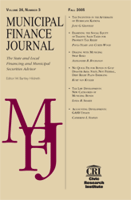Complete Issue
Author: W. Bartley Hildreth.
Source: Volume 35, Number 03, Fall 2014 , pp.1-78(78)

< previous article |return to table of contents
Abstract:
In 1939, Roy Blough of the U.S. Treasury Department stated the need to bring the “hidden subsidy” of state and local bond tax exemption into the open. In 1940, Professor Lawrence Seltzer called for a direct cash outlay instead of the tax-exemption subsidy. Thereafter, with the advent of tax expenditure reports and the work of various scholars and policy researchers, the subsidy value was well documented. Direct pay instead of tax exemption remained an untested concept until the Build America Bond (BAB) program of 2009–2010. During this statutory experiment, the federal government paid state and local government debt issuers a 35% subsidy of the annual interest cost for using taxable BABs instead of tax-exempt debt. In her last research project, the late economics professor Shama Gamkhar teamed with (now) public affairs professor Beibei Zou to examine the effect of tax-exempt status on municipal bond yields in Texas and to determine whether the yield spread between tax-exempt and taxable (BAB) bonds was compensated by the BAB subsidy. As expected, results reveal that taxable bonds have higher yields than tax-exempt bonds, holding the other variables the same. Based on this information, the authors calculate that the federal government oversubsidized BAB issuers by 54 basis points, producing a revenue neutral subsidy rate of 24% (instead of the 35% for BABs). One hurdle in conducting research on municipal bonds is obtaining a full accounting of transaction costs and then assessing the impact of those costs. Public finance professors Mark D. Robbins and Bill Simonsen examine the outliers of transaction costs among California state and local bond sales from 2007 through 2009. They find that observable characteristics do not explain issuance costs generally but that a further analysis of the worst cases reveals certain characteristics of why issuers paid unusually high issuance costs. Measuring local government fiscal health is a much discussed and debated concept. Preeminent economist Richard M. Bird provides sage reflections on the concept and measurement of urban fiscal health based on his extensive global experience. He concludes that good work requires both a systemic analytical approach and detailed local knowledge. I would like to dedicate this issue to the memory of my dear friend Shama Gamkhar. Her untimely death in a plane crash with her husband occurred just two days after she finished a summer of research here in the Andrew Young School of Policy Studies, an enjoyable summer that I hosted. She submitted her paper in those last days. It was subject to the blind peer review process and was successfully revised by Beibei Zou.Keywords: Build America Bond Program; Municipal Bond Transaction Costs; Urban Fiscal Health
Affiliations:
1: Georgia State University.